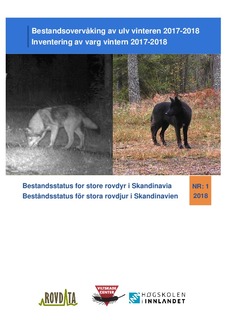| dc.contributor.author | Wabakken, Petter | |
| dc.contributor.author | Svensson, Linn | |
| dc.contributor.author | Maartmann, Erling | |
| dc.contributor.author | Åkesson, Mikael | |
| dc.contributor.author | Flagstad, Øystein | |
| dc.coverage.spatial | Skandinavia, Skandinavien | nb_NO |
| dc.date.accessioned | 2018-06-01T08:26:53Z | |
| dc.date.available | 2018-06-01T08:26:53Z | |
| dc.date.issued | 2018 | |
| dc.identifier.isbn | 978-82-426-3247-0 (dig. utg) | |
| dc.identifier.isbn | 978-91-984194-3-6 (tryckt utg. Utgiver: Viltskadecenter, SLU) | |
| dc.identifier.issn | 2387-2950 | |
| dc.identifier.uri | http://hdl.handle.net/11250/2500013 | |
| dc.description.abstract | Monitoring goals and methods:
Wolves in Sweden and Norway are members of a joint cross-boundary Scandinavian wolf population. In both countries, the wolf population is being monitored each winter. The Swedish Environmental Protection Agency and the Norwegian Environment Agency have joint Scandinavian guidelines and instructions for monitoring of wolves; these guidelines have been used since winter 2014-2015.
Numbers, distribution and trends in the wolf population in Scandinavia are primarily determined through a survey of family groups and territorial pairs during 1 October - 31 March. The survey of wolves is done mainly through snow-tracking and DNA-analyses of scats, urine and hair. Information from GPS-collars, other research data and dead wolves are used when available. The County Administrative Boards in Sweden and the Norwegian Nature Inspectorate (SNO) together with Inland Norway University of Applied Sciences in Norway are responsible for collecting field data. They also confirm reports of tracks and other observations by the public. For the wolf monitoring, contributions from the public are very important.
Number of family groups and scent-marking pairs:
During winter 2017-2018, 41 family groups were documented in Scandinavia; 28 within Sweden, five across the Norwegian-Swedish border, and eight within Norway. 31 territorial pairs were confirmed; 23 within Sweden, five across the border and three within Norway.
Population size:
Using the same method as last winter and based on the number of reproductions, Scandinavian wolf numbers were estimated to 410 (95% CI = 324-533). The Swedish sub-population was estimated to 305 wolves (95% CI = 241-396), including half of the cross-boundry ones. The calculation includes both alive and dead wolves during the monitoring period. The smaller Norwegian population was counted directly in the field. Including half of the 45 cross-boundary wolves, a total of 92-94 wolves were counted in Norway.
Genetics:
A previously known Finnish-Russian female wolf was still resident within the population’s breeding range (Örebro County), where she raised a F1-litter of pups born in 2017. One new Finnish-Russian immigrant wolf was confirmed in Scandinavia during the winter 2017-2018, outside the breeding range in Northern Sweden (Norrbotten County), and an offspring from an unknown Finnish-Russian wolf was confirmed in Southern Sweden (V. Götaland County) In addition, 14 F1 offspring from three earlier Finnish-Russian immigrants were confirmed in Scandinavia, including eight scent-marking adults in family groups or pairs.
The estimated average inbreeding coefficient in family groups was 0.23 this winter, similar to the last monitoring season. | nb_NO |
| dc.language.iso | nob | nb_NO |
| dc.publisher | Rovdata og Viltskadecenter, SLU | nb_NO |
| dc.relation.ispartofseries | Bestandsstatus for store rovdyr i Skandinavia;1-2018 | |
| dc.subject | Bestandsstatus for store rovdyr | nb_NO |
| dc.subject | ulv | nb_NO |
| dc.subject | Canis Lupus | nb_NO |
| dc.subject | antall familiegrupper | nb_NO |
| dc.subject | antall revirmarkerende par | nb_NO |
| dc.subject | antall valpekull | nb_NO |
| dc.subject | bestandsstørrelse | nb_NO |
| dc.subject | bestandsutvikling | nb_NO |
| dc.subject | overvåking | nb_NO |
| dc.subject | varg | nb_NO |
| dc.subject | antal famlijegrupper | nb_NO |
| dc.subject | antal revirmarkerande par | nb_NO |
| dc.subject | antal föryngringar | nb_NO |
| dc.subject | populationens storlek | nb_NO |
| dc.subject | beståndsutveckling | nb_NO |
| dc.subject | inventering | nb_NO |
| dc.title | Bestandsovervåking av ulv vinteren 2017-2018. | nb_NO |
| dc.type | Report | nb_NO |
| dc.rights.holder | © Rovdata. Publikasjonen kan siteres fritt med kildehenvisning. © Viltskadecenter, SLU.Publikationen kan citeras fritt med källhänvisning | nb_NO |
| dc.subject.nsi | VDP::Matematikk og Naturvitenskap: 400::Zoologiske og botaniske fag: 480 | nb_NO |
| dc.source.pagenumber | 54 | nb_NO |
| dc.relation.project | Miljødirektoratet: M-1044|2018 | nb_NO |
| dc.relation.project | Naturvårdsverket i Sverige | nb_NO |
